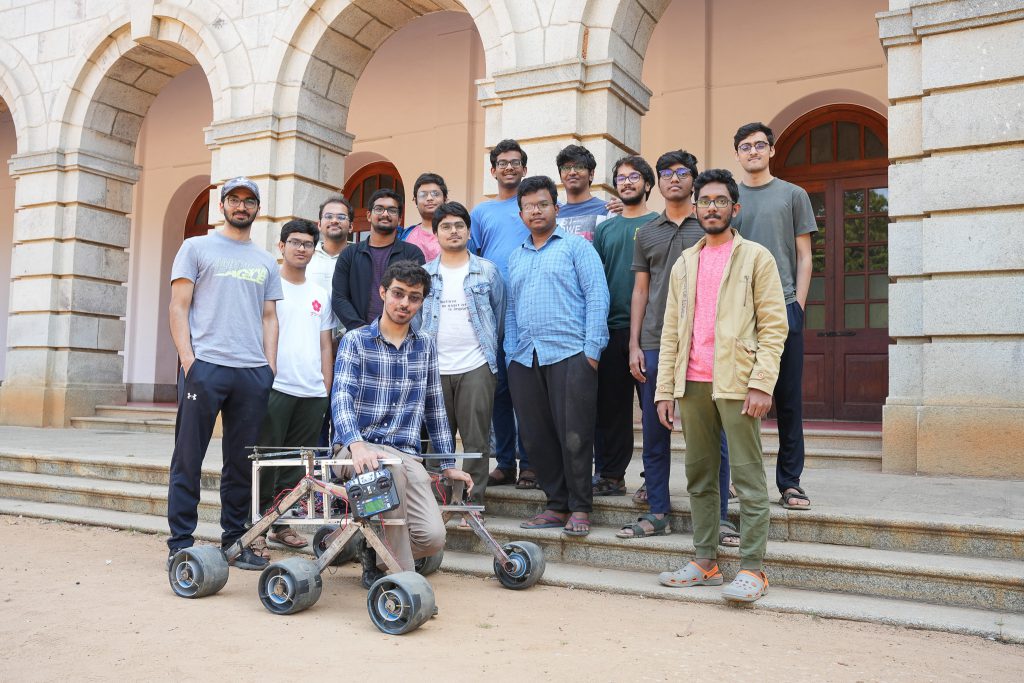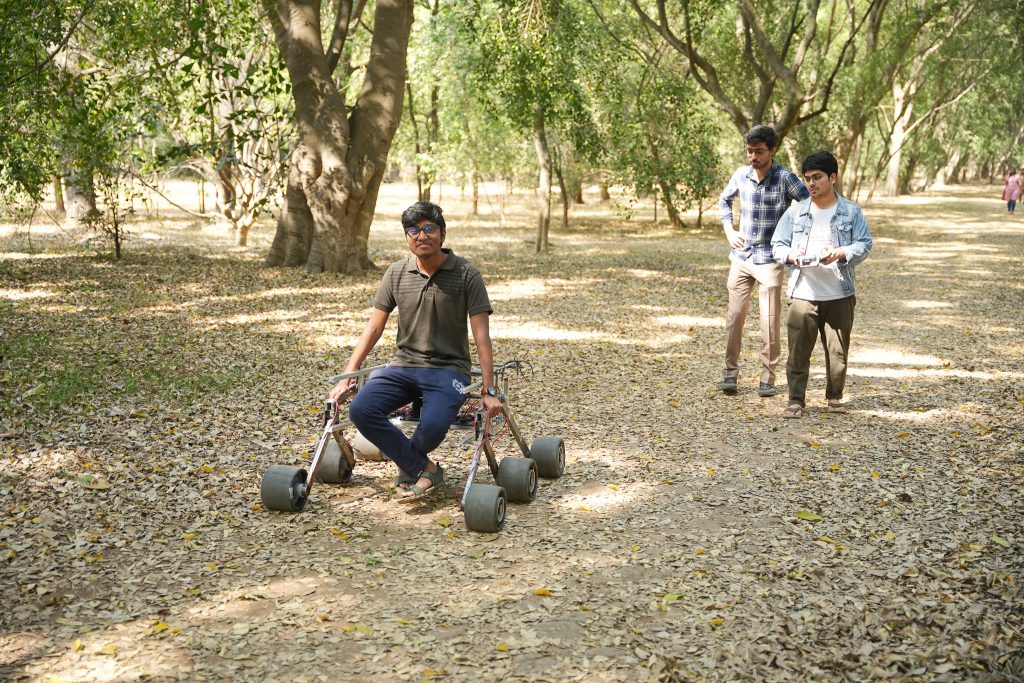IISc’s UG students are designing a prototype that could help scientists explore Mars, as part of an international competition

In the Old Physics Building, tensions are running high. Tucked away in a corner of the first floor, the workspace is crammed with batteries, pipes and boxes. Amidst the disorganised and dusty shelves, a group of students packs into the meeting room, disregarding the lack of chairs. Their attention is all on the object in the centre of the room: A printer-sized rover that they are in the process of building.
Among the students, a debate rages about how they are going to procure wheels for the rover. Why not get it 3D printed to save on cost, suggests one student, pointing to the 3D printer lying in a corner. Another one dismisses the idea, saying that they haven’t tested the reliability of the product. As they debate the pros and cons, the clock is ticking. Their deadline to finish making the rover is inching closer.
The competition that the team is shooting for is called the University Rover Challenge (URC), organised by the Mars Society, an international non-profit organisation that seeks to encourage student teams to build rovers that could potentially work on Mars. The IISc team, who call themselves “Vicharika” (one who thinks), are participating in the competition for the first time.
Powering Forward
“Vicharika was initially conceived as a robotics club. However, it didn’t materialise since the idea lacked support,” explains team member Sahil Chaudhary, a second year BTech student in Mathematics and Computing. When they approached Shishir Kolathaya, Assistant Professor at the Robert Bosch Centre for Cyber-Physical Systems (RBCCPS), he advised them to look for competitions to start with so that people would feel incentivised to participate in such a club. That was when they came across the University Rover Challenge (URC).
Started in 2007, URC is held annually at the Mars Desert Research Station, outside Hanksville, Utah, in the USA. The site is a large barren desert, with soil composition similar to Mars. Over a hundred college teams compete in this robotics challenge to design and build the next generation of Mars rovers that will one day work alongside astronauts exploring the red planet.
“Not just robotics, the rover needs expertise in communication, mechanical and electrical engineering, and even capabilities in biology to detect life in the Martian soil,” explains Sidak Grewal, team leader and second year Bachelor of Science (Research) student. The rover that the IISc team is developing is fitted with an arm capable of performing a wide range of complex mechanical tasks, such as pressing keyboard keys, flipping buttons, lifting objects, and tightening screws. These tools then need to be packed into a compact machine and tested in the harsh sandy terrain of the desert. The rover has to be developed in stages within specified deadlines, and the team needs to submit various progress reports and plans at different times. The final competition takes place in the first week of June.

Sidak adds, “The scoring depends entirely on the performance on the field, and there’s no scope for mistakes there. Even if you have good plans and a great vision, it doesn’t matter if the rover fails.”
Vicharika comprises about 25 people with varied backgrounds and experiences. The team membership isn’t limited by experience or field, but by the willingness to contribute and learn. The core team is made up completely of undergraduate students, with PhD students joining in as mentors and advisors. “We didn’t advertise it initially since we were unsure about going ahead. So, the first few people learnt [about it] through word-of-mouth. But this helped us create a strong core of highly enthusiastic and dedicated people,” explains Sahil.
“I have worked on robotics projects since the sixth grade and wanted to start a robotics club here. I told Sahil about my experience and joined URC to work on the robotic arm,” says Pratham Gupta, a first year BTech in Mathematics and Computing student. “I have a hard time saying no to problems. The bioscience module of the rover was one such problem due to the novelty and challenges involved. Hence, I joined the team,” says Dhruv Gupta, a third year Bachelor of Science (Research) student.
‘Not just robotics, the rover needs expertise in communication, mechanical and electrical engineering and even capabilities in biology to detect life in the Martian soil’
“It’s great to have professors who are so readily available and excited to help us. For example, we approached Kaushik Basu [Electrical Engineering] for help with the electronics, and he offered us help with the power distribution board too,” Sidak explains. “Similarly, Koushik Viswanathan [Mechanical Engineering] helped us source our components and gave us access to many of the tools and materials in his lab.”
“The interdisciplinary nature of research at IISc lets you explore these varied applications in every field. I am a biology major and want to explore biological applications in space and engineering. URC provided the perfect platform to explore such frontiers,” says Swaraj Nandi, a second year Bachelor of Science (Research) student.
Sahil adds that another advantage has been the ease of funding. “When we corresponded with older teams from other places, we realised that the lack of funds was a great hurdle for them.” Fortunately, Vicharika received funds from RBCCPS, which proved to be a morale booster for the new team. “Bharadwaj Amrutur [the Chair] immediately agreed to our budget and offered more if the need arises. It was the greatest privilege for a group of students planning to start something new, and it motivated us a lot.”
Mission-mode
The challenge involves completing four missions expected from the rover in future space explorations. For the science mission, the rover has to collect and analyse soil samples using onboard instruments. The analysis includes searching for signs of life and geological data such as water flow, minerals and soil structure. Under the delivery mission, the rover is required to find and deliver objects over various rugged terrains. For the equipment servicing mission, the rover has to perform complex tasks such as tightening screws, typing on a keyboard, inserting a USB drive, and operating a joystick. The competition also involves an autonomous navigation mission, in which the rover has to travel to different coordinates specified by the Global Navigation Satellite System, which is similar to the Global Positioning System (GPS). This has to be done autonomously, without any input from the control room, and requires complex codes and programs to function correctly.
The team has designed the rover with six modules to undertake these missions successfully. The communication module enables contact with the rover over long distances. The navigation and control stack uses software programs. The electronics module handles the power board and circuits. The mechanical module includes the body, wheels and chassis. The robotic arm has to undertake tasks like equipment repair. Finally, a life sensing module looks for signs of life on the planet.

It is this life-sensing module of the rover that is the most unique and challenging. Not only should it look for living organisms, but also find evidence of extinct life. Molecular assays, which are used to confirm the presence of biomolecules – like proteins that are generally found in living organisms – do not work very well for extinct life, because they would have degraded over thousands of years. “Testing for extinct life is very complicated. We can do size sequencing with the molecules, where the smaller-sized pieces are more likely to be from fossils. On the other hand, intact biomolecules are likely to come from a living organism,” Dhruv explains. To identify the biomolecule, they use a nanopore – a tiny hole of nanometre size with electric current flowing in it. Collected sample is passed through the pore using very narrow pipes. When a biomolecule passes through, resistance spikes and the electric current changes, indicating the presence of the biomolecule.
However, challenges remain as creating the nanopore and testing it within the schedule might not be possible. With the deadline approaching in March, they are looking at other techniques like colorimetry – where a light beam is passed through the sample – to identify different compounds.
It is the life-sensing module of the rover that is the most unique and challenging
The team plans to build three prototypes for the competition. The first one focuses mainly on manual control, which they tested successfully in September 2023. The second prototype will see the addition and testing of other components such as communication and navigation, which they plan to build, fulfilling all competition requirements. They want the third prototype to be a refined version of the second, with changes based on test results. The communication module has already achieved a speed of 100 Mbps over 10 km, and they are currently working on the navigation for the second prototype.
“Navigation includes planning, mapping and localisation. It’s very important to process the sensor’s data to estimate the position of the rover and navigate in the desert with sloping hills. But we got the planner program working very fast with help from Pushpak Jagtap [RBCCPS], who gave us the idea of using his Control Barrier Certificate as the local planner. We are trying to finish the rest very soon,” Sahil explains.

“Such competitions motivate all of us to explore more in the field and help the domain itself to expand further,” says Sahil. Crucially, such projects help gather critical data on the working of these machines and bring forward innovative solutions for problems in space exploration. Swaraj says, “It is not so much about sending the rover to space as it is about testing various modules and concepts in conditions similar to that of Mars.”
With the current cycle of URC coming to an end in June, the team finally wants to make the idea of a robotics club a reality. “During the project, we identified many difficulties that create a hurdle for people interested in robotics. After conceiving an idea, you have to order stuff, get permissions, adjust your schedule. This dampens the motivation of people,” explains Sidak. They envision the robotics club to bring down these barriers of entry. “We have set up a 3D printer, a mini lathe [a machine used for shaping metal], a vice [to hold the workpiece during hand operations], a big Bosch cutter, and hand grinder, and plan to get more tools.” They have already started working on plans to build a drone with flaps and cheaper telescope mounts used to automatically position telescopes in the night sky.
Sidak continues, “All of us here at Vicharika share this belief that the club should be open and responsive to the community’s needs. We think it resonates with our founder JN Tata’s ideology. It should act as an enabler for people to explore the exciting and promising field of robotics.”
Shloak Vatsal is a second year Bachelor of Science (Research) student at IISc and a science writing intern at the Office of Communications




